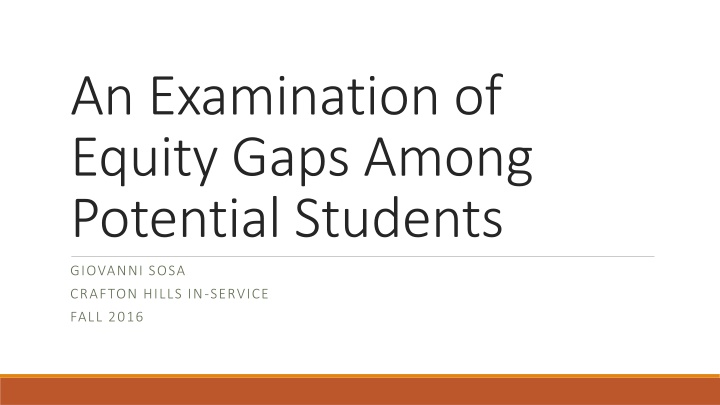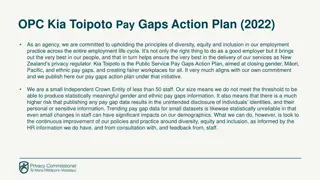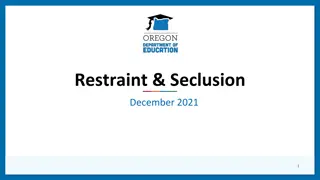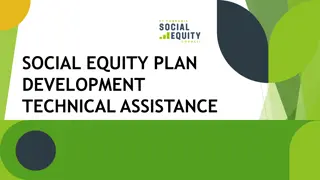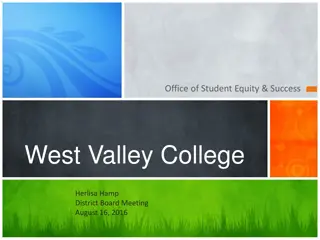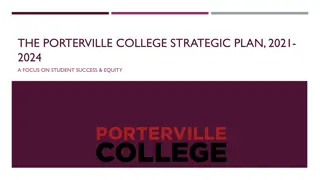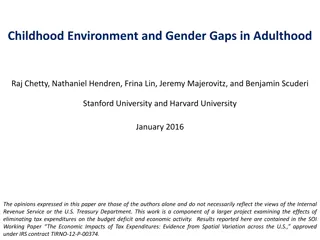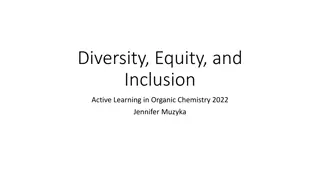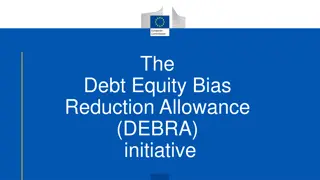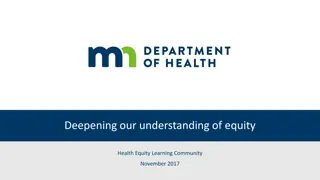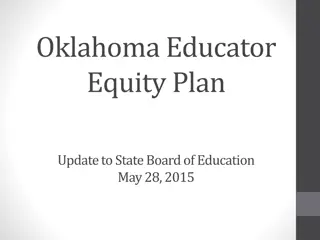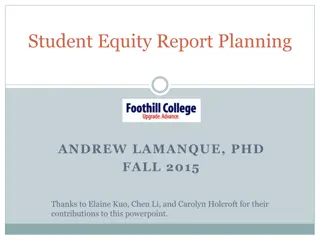Equity Gaps Among Potential Students: Fall 2016 Analysis
Examination of equity gaps among potential students applying but not enrolling in Fall 2016 at Crafton Hills. The study investigates demographic characteristics (ethnicity, gender, age) and engagement behaviors through application, orientation, and assessment data. Disproportionate impact and statistical models explore differences in representation and participation rates across groups, addressing research questions on demographic associations and interactions.
Download Presentation

Please find below an Image/Link to download the presentation.
The content on the website is provided AS IS for your information and personal use only. It may not be sold, licensed, or shared on other websites without obtaining consent from the author.If you encounter any issues during the download, it is possible that the publisher has removed the file from their server.
You are allowed to download the files provided on this website for personal or commercial use, subject to the condition that they are used lawfully. All files are the property of their respective owners.
The content on the website is provided AS IS for your information and personal use only. It may not be sold, licensed, or shared on other websites without obtaining consent from the author.
E N D
Presentation Transcript
An Examination of Equity Gaps Among Potential Students GIOVANNI SOSA CRAFTON HILLS IN-SERVICE FALL 2016
Primary Aims Primary aim was to identify possible equity gaps among students applying but not enrolling (i.e., potential students) Additional statistical analyses examined potential equity gaps among those partaking in orientation and/or assessment but not enrolling Three demographic characteristics were examined: Ethnicity Gender Age
Overview of Data Sources and Methodological Approach Application records among students applying for Fall 2016 Specifically identified students having submitted an application but failing to enroll for Fall 2016 as of July 27th, 2016 Orientation and Assessment data (through 7/27) utilized to determine engagement behaviors Examined demographic differences among those having applied but not enrolled and among two specific sub-groups: (a) Those that had completed an orientation, and (b) those that had completed an assessment
Overview of Data Sources and Methodological Approach (Continued ) Disproportionate Impact was examined to identify potential demographic differences: Proportionality Index (same group comparison) used to compare all applied but not enrolled individuals (i.e., potential students) to Fall 2015 enrolled students Research Question Answered: Was the representation of a demo group, such as males, the same among enrolled students as it was among potential students? 80% Index (between group comparison) used to explore potential differences within orientation and assessment sub-groups Research Question Answered: Is the participation rate in orientation similar across all the age groups, or does at least one group have significantly lower participation rates.
Overview of Data Sources and Methodological Approach (Continued ) Two separate linear statistical models also developed to examine the potential association of each demographic characteristic to the likelihood of partaking in orientation and assessment Research Question: Is age more closely associated with the likelihood of partaking in orientation than ethnicity? Interactions between demographic variables (e.g., Age X Gender) were also examined in aforementioned statistical models Research Question: Does the association between age and likelihood to orient depend upon the gender of the potential student?
Findings Sample Sizes of Groups A total of 2,068 had applied but not enrolled in Fall 2016 (as of 7/27) Among the 2,093, 565 had participated in orientation (27.0%) Among the 2,093, 292 had participated in assessment (14.0%)
Findings Potential vs. Actual Students Comparison of All Potential Fall 2016 Students (as of 7/27) to All Enrolled Students (Fall 2015) Asian students were disproportionately represented among potential students Fall 16 Potential Students Fall 15 Students Proportionality Index Effect Size (d) Ethnicity Count % Count % Asian 173 8.3 321 5.6 1.48 -0.23 African American 171 8.2 444 7.7 1.06 -0.04 Caucasian 663 31.7 2,293 39.9 0.79 0.20 Hispanic 1,063 50.8 2,587 45.0 1.13 -0.13 Total 2,070 100% 5,245 100% 1.00
Findings Potential vs. Actual Students (Continued ) Comparison of All Potential Fall 2016 Students (as of 7/27) to All Enrolled Students (Fall 2015) Those 19 or younger were disproportionately represented among potential students Fall 16 Potential Students Fall 15 Students Proportionality Index Effect Size (d) Age Group Count % Count % 19 or Younger 957 45.7 1,828 31.8 1.44 -0.33 20 24 562 26.9 2,331 40.5 0.66 0.34 25+ 574 27.4 1,592 27.7 0.99 0.01 Total 2,093 100% 5,751 100% 1.00
Findings Orientation Only age was statistically associated with the likelihood to partake in orientation The odds of partaking in orientation declined by 3.5% for every additional year of age (Median Age = 19) Participated in Orientation Participation Rate Effect Size (d) Age Group Total Cohort 80% Index 19 or Younger 957 322 33.6% 100% 20 24 562 130 23.1% 0.69 -0.29 25+ 574 113 19.7% 0.59 -0.40 Total 2,093 565 27.0%
Findings Assessment Only age was statistically associated with the likelihood to partake in assessment The odds of partaking in assessment declined by 9.1% for every additional year of age (Median Age = 18) Participated in Assessment Participation Rate Effect Size (d) Age Group Total Cohort 80% Index 19 or Younger 957 216 22.6% 100% 20 24 562 44 7.8% 0.35 -0.68 25+ 574 32 5.6% 0.25 -0.88 Total 2,093 292 14.0%
Conclusions and Implications Asian (and possibly even Hispanic) applicants are disproportionately represented in the population of potential students 19 or younger applicants are disproportionately represented in the population of potential students => signals potential need to more actively recruit potential students from those groups 19 or younger applicants are significantly more likely participate in orientation and assessment than are older students => Younger students are more likely than older students to stop just shy of enrolling
Limitations and Future Directions Findings are not causal age does not cause students to participate in orientation and assessment Findings based upon data gathered prior to first day of classes some of these students may have subsequently enrolled (procrastination?) Difference between understanding the what versus understanding the why Survey and/or focus group needed may help to shed light on the why
